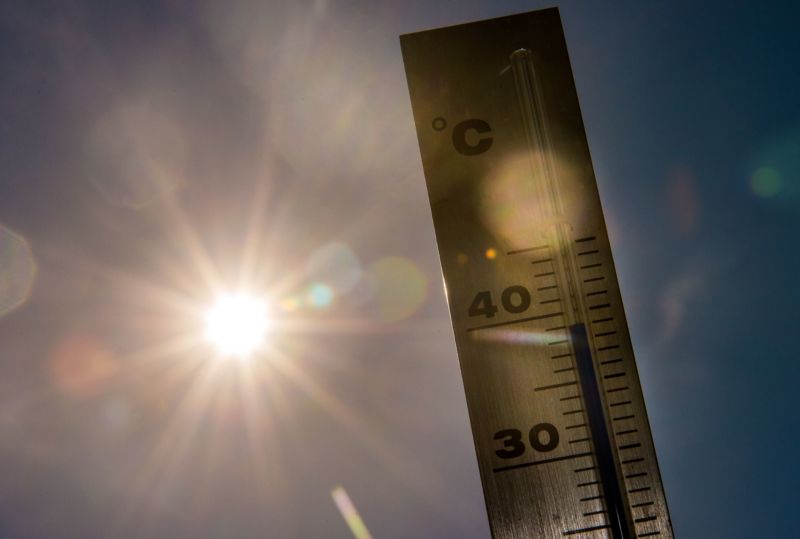
Temperature is notoriously difficult to measure, mostly because it’s an average quantity. The temperature of a room is often recorded at a single point, when it’s meant to be a measure of the average energy of the air in the room—a room that will have spatial and temporal fluctuations around that average.
As anyone who has argued over the thermostat will know, measuring the average is difficult enough. But what if I want to measure the actual fluctuations and temperature differences in the room? Then I need a thermometer that provides a temperature image.
You might be thinking “get an IR camera, dummy.” But there is a much cooler option than an infrared camera. It’s a (nearly) normal camera coupled with a laser that measures temperature from the emission of visible light.
IR cameras are not cool
Seriously, though, why not use an IR camera? Because IR is annoying. Room temperature objects emit very little thermal radiation, and you need a highly sensitive detector in your camera. IR radiation is not transmitted through glass, so it may simply be impossible to perform a measurement.
It gets worse. The amount of thermal radiation depends on the emissivity of the object. The emissivity is a number between one and zero that depends on the physical properties of the object. To correctly measure the temperature, the emissivity must be known, and most cameras can only cope with a single emissivity. What happens if an object consists of mixed materials? A seeming temperature difference might only be a difference in emissivity.
Finally, the spatial resolution is poor. Thermal radiation is around 10µm, so the spatial resolution will never be much better than 10µm. Things like cells, electronic devices, and micro-mechanical hardware all have features that are less than 10µm. It would be very nice to have a thermometer that could resolve temperature changes at smaller scales. And at small-scale, we expect small temperature differences, so any method with high spatial resolution has to have high precision.
Glowing salt is hot
This is where a group of Swiss researchers comes in. The researchers have developed a group of temperature-sensitive luminescent materials to use as tiny thermometers.
To understand how this works, let’s briefly jump into the world of molecular and atomic physics. When a material absorbs visible light, it does so by moving an electron from its ground state to an excited state. To relax back to the ground state, the electron has to lose energy. This is usually a multi-step process. First the electron will give up some energy to its surroundings in the form of vibrations—the nuclei of the molecule start shaking about—then, at last, it may emit a photon of light to return to the ground state.
Life isn’t always so smooth for an electron, though. In some materials, the electron may give up some energy in the form of vibrations and find itself trapped. Unable to emit a photon to return to the ground state, it awaits an unusual and high energy event to propel it out of the trap. If the molecule is in a hot environment, it will already be vibrating hard and may be shaken out of the trap by the molecular vibrations, allowing it to emit a photon.
The effect is that it takes longer for a cold molecule to emit light than it does for a hot molecule. The typical time it takes to emit light, called the lifetime, can be measured and then turned into a temperature with some calibration.
Unfortunately, that’s easier said than done. The issue is that luminescent materials are the teenagers of the molecular world. If you shine too much light on them, they stop working altogether. If you make them do too much work, they break. They age rapidly, so the relationship between temperature and lifetime changes on a daily basis. They’re just generally sensitive.
This is where the work of our intrepid group of researchers gets interesting. They have identified a set of 2D materials (salts) that are nicely sensitive to temperature yet don’t rapidly age or suddenly stop working. These materials can be painted on an object of interest. To measure the temperature, you shine a UV laser on the object and measure the lifetime of the reddish glow that comes off. These measurements can be made with existing camera systems, like those used in the Kinect 2 gaming system.
Fast and furious temperature imaging
The researchers show that their material provides a temperature resolution of 0.05°C—and the measurement is fast. The team made a video that shows the heat applied by a soldering tip to a sample spreading and dissipating at 100 frames per second.
This is quite a remarkable achievement. That said, I suspect there are some limitations. It is a salt, so I expect that it’s quite moisture sensitive. The temperature range is relatively limited; don’t imagine that you can use this in combustion engineering or on the hot parts of an integrated circuit. And obviously, anything you want to image must tolerate having a salt painted on it.
On the other hand, there is a whole world to explore here: you could use special imaging techniques to monitor the temperature in even smaller volumes (think 50×50×50nm boxes). This would allow us to indirectly track how energy moves around at a scale that is quite difficult to deal with: smaller than macroscopic heat transfer but larger than energy moving around a single molecule. I am looking forward to seeing more results.
Nature Materials, 2019, DOI: 10.1038/s41563-019-0416-2 (About DOIs)
https://arstechnica.com/?p=1537627

